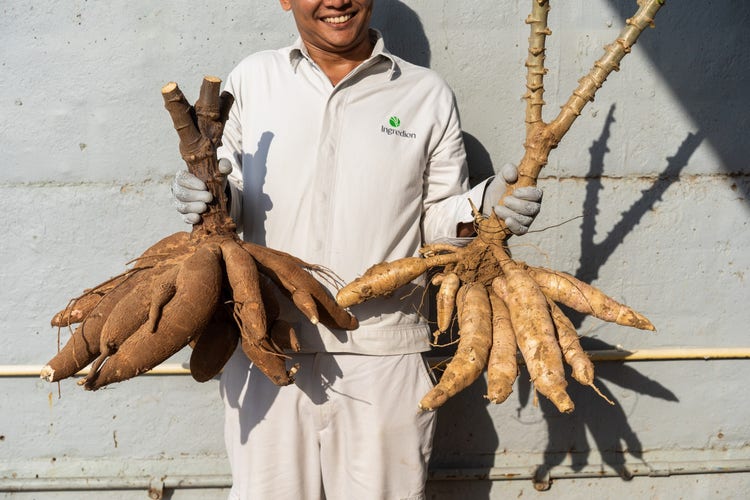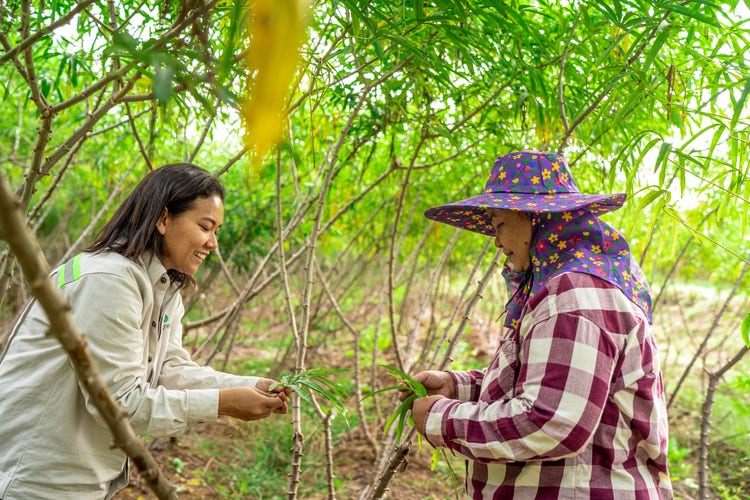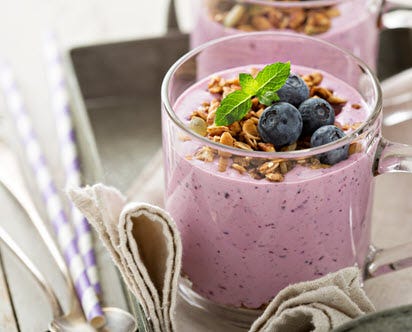
Tapioca

Differentiate your products with Ingredion’s tapioca solutions
Learn what tapioca is, how it is made and what type of texture challenges and consumer preferred claims it can deliver on.
Tapioca is a versatile ingredient that plays a crucial role in a wide range of food and beverage applications. From improving texture in dairy alternatives to adding stability in gluten-free baked goods, tapioca delivers a variety of benefits, including clean-label appeal, enhanced mouthfeel, and excellent shelf-life stability.
Sustainably sourced and carefully processed, Ingredion’s tapioca ingredients meet the highest standards of quality. Proven by being the first SAI certified Tapioca supplier, our SAI certification demonstrates our commitment to implementing sustainable agricultural practices that promote environmental, social, and economic sustainability. Whether you’re seeking to reformulate for cost savings or address consumer preferences for cleaner ingredient labels and differentiated eating experiences, our tapioca solutions help you maintain high product performance.
What is Tapioca?

What is tapioca, and how is it made?
A global food staple, native to West Africa, South East Asia and South America, known under many local common names such as yucca, mandioca, manioca, tapioca and cassava Tapioca is derived from the cassava root and mainly used as a starch or flour. Cassava is a tall semi-woody perennial shrub or tree, several meters high.
The crop requires a warm humid climate, all growth stops at about 10ºC. The stems spoil quickly, which is why a processing step close to the plantation is important.
There is no tapioca plant; instead, it is the name given to the starch extracted from the root of a cassava plant. The plant is extremely drought resistant, making it a vital crop in global food security. As a result, tapioca is the 2nd largest source for primary starch production globally (Source: Giract report).
The cassava plant is widely grown in both South America and South East Asia. Globally, Thailand is the largest tapioca starch exporting country in the world (Source: World Bank). In Thailand, Ingredion has its largest tapioca footprint, working with local farmers and processing tapioca starch since 1984. Ingredion has implemented a SMART Agriculture programme, promoting sustainability practices like regenerative agriculture to support soil health. Apart from Thailand, Ingredion sources native tapioca starch from various countries, and processes it in more than 10 factories in 4 continents.
To extract the starch, raw cassava root is peeled and grated. Those grated shavings are then soaked in water to create a pulp. It is then dried and used as either a starch thickener or as flour.
Tapioca can also be manufactured into a variety of textures, such as pearls, flakes or flour.
What is waxy tapioca?
Waxy refers to the absence of amylose in the root, which is a polymer known to gel and cause texture instability and syneresis in food products over shelf-life. Ingredion launched the very first waxy tapioca ingredients in 2016 and has since continuously broadened its product portfolio to enable customers to innovate with this new hybrid. Waxy tapioca starch characteristics enable further product innovation for food manufacturers, providing the following key benefits to manufactures:
- Higher viscosity vs regular tapioca
- Texture stability through low retrogradation, across storage conditions
- Stability with no syneresis after storage at -18℃
- Higher clarity vs other waxy varieties like corn or rice
What is tapioca used for?
There are many uses for tapioca. It is an excellent texturiser with a neutral flavor profile, allowing it to be used in both sweet and savory formulations.
In its pearl form, tapioca is commonly used in sweet treats like bubble tea (also called boba milk tea) and tapioca pudding. Both are cold, creamy desserts with chewy tapioca pearls as the star ingredient.
In its flour form, tapioca can be used as a thickening agent in soups, stews, pies, and other hot formulations. It's also popular in gluten-free baking. Pão de queijo is a Brazilian cheese bread using tapioca, which has gained popularity alongside gluten-free diets. But it's also used as a gluten-free substitute in all kinds of baked goods, either alone or mixed in with other gluten-free ingredients such as coconut flour.
What do consumers think of tapioca?
Tapioca has a high consumer acceptance across EMEA. The sensory properties of the starch and flour show a high liking across consumers, due to the clean flavour and creamy texture. Clean label ingredients (including tapioca) are expected to post a 17.5% CAGR by 2030. Generally, a flour label has a higher consumer preference over starch. compared to starch. Ingredion is the only company offering the only multifunctional native flours, which perform similar to a modified starch in process resistance and stability over shelf-life to meet that demand.
This growth bodes well for food manufacturers since 71% of consumers are happy to pay more for products with natural ingredients. And 30% are willing to pay at least 20% in higher prices. Much of this recent demand has been driven by the COVID-19 pandemic as consumers are placing a higher priority on healthy foods with natural ingredients.
Food manufacturers seek to differentiate themselves and offer new eating experiences, where tapioca can provide that offering.
Learn more about the benefits and consumer preferences for clean label and flours.
Benefits and Applications
Benefits of tapioca texturisers
Processing benefits: Gelatinisation temperature of Tapioca starch is lower than of waxy maize starch but higher than of potato. Uniquely a low hot viscosity during processing can lead to improved heating kinetics, lower backpressure during UHT Processing and e.g., faster retorting times.
Enhancing flavours: Tapioca starches are extremely bland in flavour, due to the nature of the cassava root composition (high carbohydrate, low fat and protein).
Label appeal: In addition to meeting gluten-free standards, tapioca also meets standards for kosher, halal and vegan diets. Plus, it's non-GMO, making it an excellent ingredient to use to meet many label requirements.
Sustainably sourced: By the end of 2025 >99% of our tapioca starch will be sustainably sourced; we were the first starch manufacturer to commit to an ambitious sustainability sourcing target for tapioca, being third party audited and certified.
Creamy Texture: Tapioca starches are known for their creamy mouthfeel which is sensorially described as high mouthcoating and slow meltaway. Finally, tapioca is frequently used as a binding agent in a range of food products to give thickness and volume without impacting flavor. Swap out modified starch for a high-performing tapioca alternative that leaves a pleasant mouthfeel without impacting flavor.
Gluten-free: Tapioca can be used in many diet-friendly formulation. It is naturally gluten- and grain-free. Tapioca can act as an excellent wheat substitute in gluten-free baking and as a thickening agent in other formulations as well.

Sustainability: A Key Focus For Our Tapioca Solutions
There are a number of tapioca products to choose from depending on your formulations needs. Ingredion offers products to address many uses for tapioca N-DULGE® C1 N-DULGE C1., for instance, is a co-texturizer used to create rich creaminess in dairy formulations. You will notice an enhanced mouth-coating texture that gives your product slightly more flow and smoothness than you could achieve without the addition of tapioca.
Another option is NATIONAL FRIGEX™, which is another tapioca-derived starch from Ingredion. This one is designed to maintain its stability under a range of storage conditions, including low temperatures, heat and acidity.
Ingredion’s Tapioca products also support clean label claims, so you can maintain premium texture and taste while still addressing consumer preferences for clean ingredient labels and eating experiences.

Here are some common products that are well-suited for tapioca:
- Soups
- Sauces
- Dressing
- Dairy desserts
- Dairy drinks
- Yogurt
- Fruit preparations
- Baby food
Explore Our Tapioca Ingredient Solutions
Ready to boost your brand's health labels by making the switch to tapioca?
Explore oir line of tapioca products today?
The information described above is solely offered for your consideration, investigation and independent verification. It is up to you to decide whether and how to use this information. Ingredion Incorporated and the Ingredion group of companies make no warranty about the accuracy or completeness of the information contained above or the suitability of any of their products for your specific intended use. Furthermore, all express or implied warranties of non-infringement, merchantability or fitness for a particular purpose are hereby disclaimed. Ingredion Incorporated and the Ingredion group of companies assume no responsibility for any liability or damages arising out of or relating to the foregoing.



